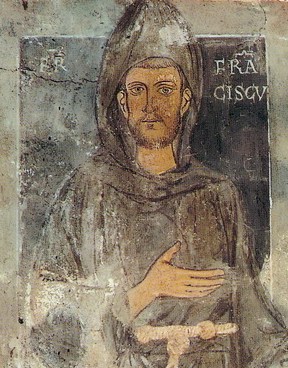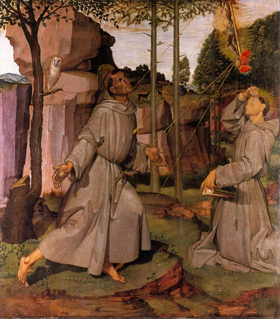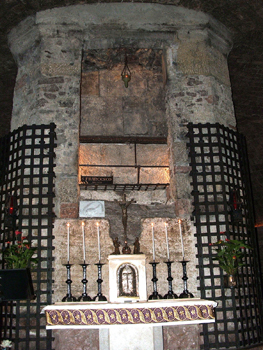For Sunday June 26, 2016
Lectionary Readings (Revised Common Lectionary, Year C)
2 Kings 2:1–2, 6–14 or 1 Kings 19:15–16, 19–21
Psalm 77:1–2, 11–20 or Psalm 16
Galatians 5:1, 13–25
Luke 9:51–62
The gospel this week begins a long section right in the middle of Luke's story that scholars call his "travel narrative" or "journey to Jerusalem." The tone and content of this section clearly pivot from what has come before.
Luke 9:51 says that “when the days drew near for him to be taken up, he set his face to go to Jerusalem." Luke repeats this idea at least eight times in this twenty-page section, emphasizing that Jesus is heading inexorably to Jerusalem. The travel narrative ends with the triumphal entry of Jesus into Jerusalem, where Luke says that "every day he was teaching at the temple" (19:47).
As with most important journey stories — think of Homer, Abraham, or the Israelites — Luke isn't primarily interested in geography. This isn't a travelogue. If you fire up a Google Map, you'll see that the path that Jesus takes to Jerusalem is erratic at best. Luke is more interested in theology than geography.
For three years Jesus had been on the way, a road, a path, or a pilgrimage. Yes, the crowds were amazed. The rumor mill had been in overdrive. But the way of Jesus, who himself becomes the way for us, was also a very difficult path.
When Jesus taught in his home town, the village that had helped to raise him "took offense at him" and said he was demon-possessed. When his family saw the raucous crowds that hounded him, "they went to take charge of him, for they said, 'He is out of his mind.'" John says that "even his own brothers did not believe in him."
The disciples "grumbled" and "took offense." Who can accept his "hard sayings," they wondered? John says that "many of his disciples turned back and no longer followed him."
 |
|
Oldest known portrait of St. Francis, 13th century.
|
In last week's gospel Jesus was run out of town, and in this week's gospel he was denied passage through a Samaritan village. At the very end, except for the women, his closest disciples denied that they knew him and fled for the tall grass.
In Jerusalem, his journey ends with the Via Dolorosa, the way of grief, sorrow, pain, and suffering. The Sent One of God came to show us the love of his Father, and so at the end of his life he "set his face to Jerusalem," knowing that there he would meet his final conflict with the religious authorities and the Roman state.
This week my wife and I begin a third pilgrimage — walking the Via Francigena or the Way of St. Francis of Assisi (1181/2–1226). God willing, we'll walk 330 miles in 28 days, beginning in Florence, passing through Assisi, and then ending in Rome. We'll travel about as light as is possible — back packs with not much more than two shorts, two shirts, two socks.
St. Francis is one of the most revered saints in Christian history, but any account of his life faces two formidable challenges — the complexity of the medieval sources, and the saintliness of a subject who evokes hagiography.
A few years ago, I read the new gold standard on St. Francis, Augustine Thompson's Francis of Assisi; A New Biography (2012). His rigorous historical method moves beyond mere speculation and pious edification, and yet does so with a genuine reverence for his subject.
Francis's family was wealthy but not aristocratic. In 1205, Francis renounced his family and wealth in favor of a vagabond life as a lay penitent, centered around serving lepers, manual labor repairing churches, and fervent devotion to the Eucharist.
 |
|
The Stigmata of Saint Francis by Bartolomeo della Gatta, tempera on wood, c. 1487.
|
In 1208, two followers joined him, and the three of them sought priestly advice on their "form of life." On April 16, 1208 the priest opened the missal to three random passages that would later define the Franciscan Order: go and sell all you have, take nothing for the journey, deny yourself and follow Jesus.
For many years after this official conversion to radical renunciation, the Franciscan movement was fluid and "free form." By 1216, Francis was a celebrity, and by 1219 he was even known in far away England. Nonetheless, there was no official "rule" or governance until 1221.
Therein lies one of the many complexities of what Thompson calls a "deeply conflicted" Francis. How do you bottle the lightning of a growing, international and dynamic mass movement, led by a famous figure, who lacked the skills and temperament of organizational leadership?
Francis resigned as head of the movement in 1220, but everyone knew that he held all the power. How could he be "less than all" and "subject to all" if he had to judge others as their leader? Francis never made peace with the necessary transformation of his movement into a regularized institution.
What emerges in Thompson's telling — thank God! — is not an inimitable figure who transcends history, and not some cuddly figure who was nice to animals, but a normal human being who grappled deeply with the "way" of Jesus to "give all, take nothing, and embrace the cross."
Our own pilgrimage will be a pale and even artificial imitation of the way and ways of St. Francis. Even so, we'll follow an ancient ritual that started not long after the last days of Jesus in Jerusalem and that continues today — re-enacting his own pilgrimage to the Father. Today, every Friday, the Franciscans lead a procession that walks the Via Dolorosa.
 |
|
The final resting place of St. Francis in Assisi.
|
When we get to Rome, if the line isn't too long and the sun isn't too hot, we hope to walk through the Vatican "doors of mercy." Back on December 8, 2015, Pope Francis declared an "extraordinary" jubilee "Year of Mercy."
Francis began the Year of Mercy with a symbolic ritual — knocking on the massive bronze doors of the Basilica of St. Peter, and then walking through them. Whereas the doors are usually sealed, this jubilee year the Vatican expects about 10 million pilgrims like us to walk through those same doors.
The symbolic significance? "I am the door," said Jesus in John 10:7. And so Francis prayed, “You are the door through which we come to thee, inexhaustible source of consolation for everyone.”
“To pass through the Holy Door," said Pope Francis in his homily, "means to rediscover the infinite mercy of the father who welcomes everyone and goes out personally to encounter each of them.” Indeed, that is our own pilgrimage prayer, and the real destination of walking the Way of St. Francis.
Image credits: (1) Wikipedia.org; (2) Wikipedia.org; and (3) Wikipedia.org.





